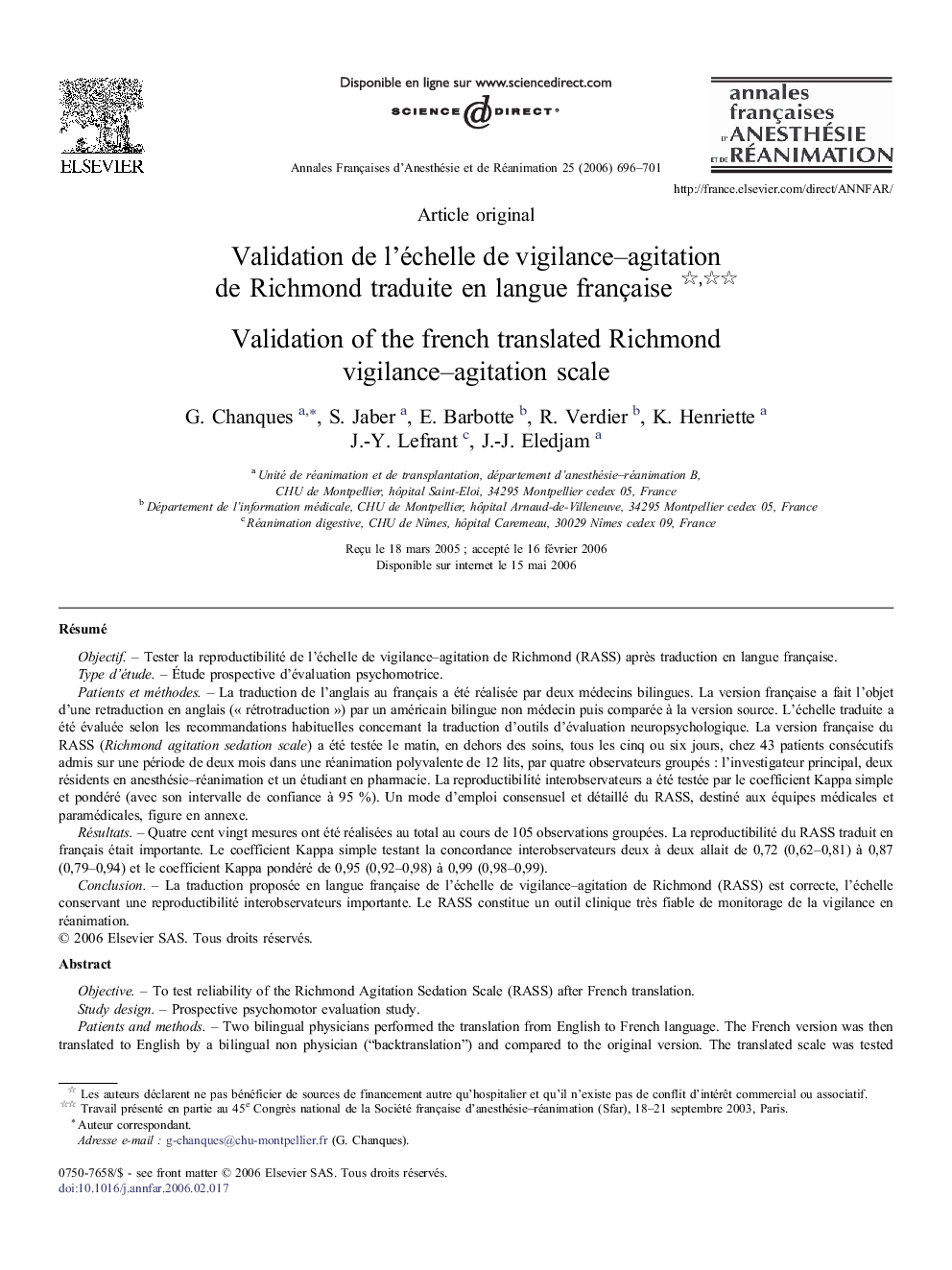| کد مقاله | کد نشریه | سال انتشار | مقاله انگلیسی | نسخه تمام متن |
|---|---|---|---|---|
| 2748260 | 1148966 | 2006 | 6 صفحه PDF | دانلود رایگان |

RésuméObjectifTester la reproductibilité de l'échelle de vigilance–agitation de Richmond (RASS) après traduction en langue française.Type d'étudeÉtude prospective d'évaluation psychomotrice.Patients et méthodesLa traduction de l'anglais au français a été réalisée par deux médecins bilingues. La version française a fait l'objet d'une retraduction en anglais (« rétrotraduction ») par un américain bilingue non médecin puis comparée à la version source. L'échelle traduite a été évaluée selon les recommandations habituelles concernant la traduction d'outils d'évaluation neuropsychologique. La version française du RASS (Richmond agitation sedation scale) a été testée le matin, en dehors des soins, tous les cinq ou six jours, chez 43 patients consécutifs admis sur une période de deux mois dans une réanimation polyvalente de 12 lits, par quatre observateurs groupés : l'investigateur principal, deux résidents en anesthésie–réanimation et un étudiant en pharmacie. La reproductibilité interobservateurs a été testée par le coefficient Kappa simple et pondéré (avec son intervalle de confiance à 95 %). Un mode d'emploi consensuel et détaillé du RASS, destiné aux équipes médicales et paramédicales, figure en annexe.RésultatsQuatre cent vingt mesures ont été réalisées au total au cours de 105 observations groupées. La reproductibilité du RASS traduit en français était importante. Le coefficient Kappa simple testant la concordance interobservateurs deux à deux allait de 0,72 (0,62–0,81) à 0,87 (0,79–0,94) et le coefficient Kappa pondéré de 0,95 (0,92–0,98) à 0,99 (0,98–0,99).ConclusionLa traduction proposée en langue française de l'échelle de vigilance–agitation de Richmond (RASS) est correcte, l'échelle conservant une reproductibilité interobservateurs importante. Le RASS constitue un outil clinique très fiable de monitorage de la vigilance en réanimation.
ObjectiveTo test reliability of the Richmond Agitation Sedation Scale (RASS) after French translation.Study designProspective psychomotor evaluation study.Patients and methodsTwo bilingual physicians performed the translation from English to French language. The French version was then translated to English by a bilingual non physician (“backtranslation”) and compared to the original version. The translated scale was tested according to usual guidelines concerning the translation of neuropsychological evaluation tools. The French version of RASS was tested on the morning of every fifth or sixth day, and 30-min after any procedure, in 43 consecutive patients admitted to a 12-bed medical-surgical intensive care unit during two months, by a group of four observers: the principal investigator, two anaesthesiology residents and one pharmacology student. Inter-rater reliability was tested using the simple and weighted Kappa coefficients (with their 95% confidence interval). A consensual and detailed “operating instructions” guide of RASS, intended for medical and nursing staff, has been added in the Annexe section.ResultsFour hundred twenty measures were performed during 105 grouped observations.Reliability of the French version of RASS was substantial. Simple Kappa coefficient, testing the concordance between observers, was ranged from 0,72 (0,62–0,81) to 0,87 (0,79–0,94) and weighted Kappa coefficient from 0,95 (0,92–0,98) to 0,99 (0,98–0,99).ConclusionsThe french translation of RASS was acceptable. The translated scale preserved substantial inter-rater reliability. Monitoring of vigilance status in intensive care settings can be performed with this reliable clinical tool.
Journal: Annales Françaises d'Anesthésie et de Réanimation - Volume 25, Issue 7, July 2006, Pages 696–701